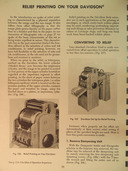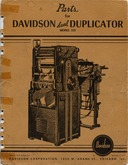These were machines which, suitably equipped, could function either as lithographic printing presses or as relief ("letterpress") printing presss. They were sold in large part as "duplicators" for office environments

310 F2d 937, Davidson vs. US (1962)
The US court cases "Davidson Corporation vs. The United States" and "Mergenthaler Linotype Company vs. The United States," as recorded in The Federal Reporter, Series 2, Volume 310, No. 937 (310 F.2d 937), December 5, 1962.
This was a suit brought by Davidson/Mergenthaler seeking a refund of the excise tax paid on the Davidson machines sold in the 1950s on the grounds that the machines were printing presses (upon which no excise tax was levied) rather than office duplicating machines (which were then subject to excise tax). They lost.
The digitization of this case reprinted here is that presented by Public.Resource.Org; it appears online at https://bulk.resource.org/courts.gov/c/F2/310/310.F2d.937.75-59.177-54.546-58.html
This case is a useful source of reliable information on the history of the Davidson machines. Here is an extract:
"From its incorporation in 1916 until approximately 1940, Davidson manufactured and sold paper-feeding devices which were invented by its founder, William Ward Davidson, Senior. Between 1924 and 1940 these feeders were purchased by the American Multigraph Corporation and its successor, Addressograph-Multigraph Corporation, for incorporation in their Multigraph Machines. In the latter five years of the above period, over 97 percent of all Davidson's sales were made to Addressograph-Multigraph Corporation, of which the Friction Feeder and the Suction Feeder were the dominant products.
"During the mid-1930's, Davidson performed development work on a variety of products, one of which was a small rotary printing machine which it planned to market primarily as a business or office machine in business concerns which required a substantial amount of reproduction work. This intention is found in the registration statement, as amended, which Davidson filed with the Securities and Exchange Commission in 1939, in connection with issues of common stock, in which statement Davidson indicated the machine would probably be called the 'Davidson Duplicator.' A subsequent statement filed by Davidson in 1940, in which were repeated references to its 'duplicators', indicated that the 'Davidson Duplicator' was practically ready for production.
"In 1940 Davidson marketed its Model 221 under the name of 'Davidson Dual Duplicator,' thereby professing the two-purpose nature of the machine — lithographic and letterpress. This machine could print on paper ranging in size from 3 by 5 inches to 10 by 14 inches, and provided reproduction either from offset plates or from type, electrotypes, rubber plates, etc., as distinguished from stencil or liquid duplicators or machines of the hectograph type. The advertisements of the 221 not only pointed out these characteristics, but stressed the advantage of offset duplication for office use, where office forms, stationery, form letters and advertising literature were used to any great extent, and the relative simplicity of operating the machine.
"Priorities created by the war emergency restricted the market to the extent that the Federal Government became Davidson's most potential customer, but only for sale of 'duplicating machines'. As all Government printing was required to be done by the Government Printing Office, the purchase of printing presses was restricted, but the various departments and agencies could purchase machines commonly considered as doing 'duplicating' work of the kind frequently performed in businesses and offices for relatively short run reproduction. Thus Davidson during the war years strongly emphasized that its 221 was a 'duplicator' for office use.
"Davidson continued to seek the office market in the years following the war and after its 1950 merger with Mergenthaler. The development and marketing of the de luxe Model 251 was accomplished after the merger, which model was designed primarily to eliminate noise and exposed parts, which were objectionable in the 221.
"While Davidson was characterizing its machines as 'duplicators' and for a period of time thereafter, none of its advertising appeared in the various printing trade media. It did appear, however, in such office equipment publications as 'The Office Management and Equipment Purchasing Guide,' which listed Davidson's machines under 'Machines, Duplicating, Offset.' Other publications carrying Davidson advertising were 'Office Appliance Buyers Guide', 'Time Magazine', 'The Office', 'Nation's Business', 'American Business' and 'Business Week.'
"Shortly after the merger, Mergenthaler realized the vast possibilities of the Davidson machines in the arts field, with their capacity to produce work comparable to larger and more complex conventional printing presses, and directed its sales activities in this direction, as well as toward the office equipment field and those businesses which operated their own printing shops (commonly called 'captive printing shops'). To implement this effort toward increasing sales in the commercial printing field, the word 'Duplicator' was dropped, and the machines were advertised as 'Davidson Dual.'
"In 1954 the name of the machines was changed to 'Davidson Dual-Lith' which name is presently used. The sales literature after 1954 for Models 241 (221) and 233, the latter of which is essentially the same as 241 except that it is larger and more rugged, continued to stress the ease and simplicity of operation to promote their utility in the business office market. ..."

Manual (1955, Extracts)
A PDF of photographs of several pages from the 1955 edition of the Davidson Offset Duplicator Manual. Despite its title, this manual covers the operation of these machines in relief printing. The extracts here concentrate on pages devoted to relief printing and a composite method of "dry offset" printing.
These photographs were taken by David Jasmund and posted to his flickr photostream as a part of a discussion thread on Briar Press in 2011 ( http://www.briarpress.org/27829). They are reprinted here with his kind permission.

Parts, Dual Duplicator Model 221 (1950)
Parts for Davidson Dual Duplicator Model 221. (Chicago, IL: Davidson Corporation, 1950)
The icon here links to a presentation of this book at The Internet Archive, where it may be read online. Here is a local copy of the PDF (476 Megabytes): davidson-dual-duplicator-221-parts-book-0600rgbjpg.pdf
The copyrights on the Davidson documentation reprinted here were not renewed, as was then required. These documents therefore entered the public domain upon the expiration of their initial copyright. The digital reprints of them here remain in the public domain.
The photographs of pages from the 1955 Davidson manual reprinted here were taken by David Jasmund and are used with his permission. Although the copyright on the underlying material has expired (see above), please do not reproduce his photographs further without his permission.
United States court judgments without further annotation are in the public domain by law. This digitization by Public.Resource.Org has been confirmed as remaining in the public domain (CC0). Its reprint here remains in the public domain.
All portions of this document not noted otherwise are Copyright © 2013 by David M. MacMillan and Rollande Krandall.
Circuitous Root is a Registered Trademark of David M. MacMillan and Rollande Krandall.
This work is licensed under the Creative Commons "Attribution - ShareAlike" license. See http://creativecommons.org/licenses/by-sa/3.0/ for its terms.
Presented originally by Circuitous Root®
Select Resolution: 0 [other resolutions temporarily disabled due to lack of disk space]